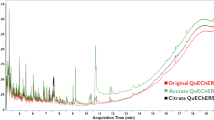Abstract
Damascena and centifolia roses are cultivated worldwide for their petal extracts that contain key odorant ingredients of perfumes. The analytical identification and quantification of pesticides in rose petals have never been described in the literature. Here, we report on a newly developed method using dispersive solid-phase extraction (d-SPE) cleanup followed by gas chromatography-tandem mass spectrometry for the quantitative determination of multi-residue pesticides in rose petals. Analytes were extracted from the matrix using acetonitrile and a mixture of salts containing magnesium sulfate, sodium citrate, sodium chloride, and sodium sesquihydrate. Samples were cleaned up twice by d-SPE applying primary and secondary amines (PSAs), magnesium sulfate, C18, and graphitized carbon black (GCB). Two fortification levels of 0.05 and 0.5 mg kg−1 were assessed for method validation purposes. The obtained pesticide recoveries were in the range of 70–120 % with a relative standard deviation (RSD) of less than 20 %. The newly developed method was allowed for the quantification of 57 pesticides residues. It was applied to pesticide residue detection in rose petals from an organic field, without treatment, compared to those from a field with classic phytosanitary treatment using fungicide and/or insecticide. We did not detect pesticide residues in rose petals from the organic field. The classically treated samples of roses contained pesticides such as chlorpyriphos and methidathion which are in accordance with the previous application of these pesticides on the roses. Insecticides were quantified at 0.05 mg kg−1 rose petal maximum.

Damascena and centifolia roses taken from an organic field

Similar content being viewed by others
References
Tascone O, Roy C, Filippi J-J, Meierhenrich UJ (2014) Use, analysis, and regulation of pesticides in natural extracts, essential oils, concretes, and absolutes. Anal Bioanal Chem 406:971–980
Fillâtre Y, Rondeau D, Daguin A, Jadas-Hecart A, Communal P-Y (2013) Multiresidue determination of 256 pesticides in lavandin essential oil by LC/ESI/sSRM: advantages and drawbacks of a sampling method involving evaporation under nitrogen. Anal Bioanal Chem 406:1541–1550
Naves YR (1974) Technologie et chimie des parfums naturels: essences concrètes, résinoïdes, huiles, et pommades aux fleurs. Masson, Paris
Lehotay SJ, Kok A, Hiemstra M, Bodegraven P (2005) Validation of a fast and easy method for the determination of residues from 229 pesticides in fruits and vegetables using gas and liquid chromatography and mass spectrometric detection. J AOAC Int 88:595–614
Lehotay SJ, Mastovska K, Lightfield AR (2005) Use of buffering and other means to improve results of problematic pesticides in a fast and easy method for residue analysis of fruits and vegetables. J AOAC Int 88:615–629
Guidance document on analytical quality control and validation procedures for pesticides residues analysis in food and feed (2013) SANCO/12571/2013
Aydinli M, Tutaş M (2003) Production of rose absolute from rose concrete. Flavour Fragr J 18:26–31
Bayrak A, Akgül A (1994) Volatile oil composition of Turkish rose (Rosa damascena). J Sci Food Agric 64:441–448
Limian Zhao JS (2012) Optimizing recoveries of planar pesticides in spinach using toluene and agilent bond elute QuEChERS AOAC kits with graphitized carbon. Agilent Technologies
Wong JW, Hennessy MK, Hayward DG, Krynitsky AJ, Cassias I, Schenck FJ (2007) Analysis of organophosphorus pesticides in dried ground ginseng root by capillary gas chromatography-mass spectrometry and-flame photometric detection. J Agric Food Chem 55:1117–1128
Wong JW, Zhang K, Tech K, Hayward DG, Makovi CM, Krynitsky AJ, Schenck FJ, Banerjee K, Dasgupta S, Brown D (2010) Multiresidue pesticide analysis in fresh produce by capillary gas chromatography-mass spectrometry/selective ion monitoring (GC-MS/SIM) and-tandem mass spectrometry (GC-MS/MS). J Agric Food Chem 58:5868–5883
Walorczyk S (2012) Gas chromatographic–tandem mass spectrometric analysis of pesticides residues in produce using concurrent solvent recondensation-large volume injection. J Chromatogr A 1222:98–108
Max F (2009) Labostat—guide de validation des méthodes d’analyse. Lavoisier, Paris
Feinberg M (2001) Validation interne des méthodes d’analyse. Ed. Techniques Ingénieur
EU Pesticides database (2014) http://ec.europa.eu/sanco_pesticides/public/?event=homepage
Banerjee K, Mujawar S, Utture SC, Dasgupta S, Adsule PG (2013) Optimization of gas chromatography–single quadrupole mass spectrometry conditions for multiresidue analysis of pesticides in grapes in compliance to EU-MRLs. Food Chem 138:600–607
Walorczyk S (2014) Validation and use of a QuEChERS-based gas chromatographic–tandem mass spectrometric method for multiresidue pesticide analysis in blackcurrants including studies of matrix effects and estimation of measurement uncertainty. Talanta 120:106–113
Acknowledgments
We thank the ‘Association Nationale de la Recherche et de la Technologie’ (ANRT) concerning the CIFRE funding for the Ph.D. thesis of O.T. We acknowledge the financial and scientific support of Waters and International Flavors & Fragrances, LMR Naturals division.
Author information
Authors and Affiliations
Corresponding author
Rights and permissions
About this article
Cite this article
Tascone, O., Shirshikova, M., Roy, C. et al. Pesticide determination in rose petals using dispersive solid-phase extraction followed by gas chromatography-tandem mass spectrometry. Anal Bioanal Chem 406, 8041–8048 (2014). https://doi.org/10.1007/s00216-014-8270-1
Received:
Revised:
Accepted:
Published:
Issue Date:
DOI: https://doi.org/10.1007/s00216-014-8270-1




